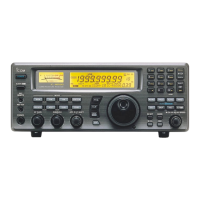Varactor diodes are employed
at
the tuned notch filter
circuit to control the center frequency of the IF signal, and
are
controlled by the CPU (MAIN unit,
IC33)
via the current
amplifier circuit
(IC7a).
•
Tuned notch
filter characteristics
4-1-5
VHF/UHF 1ST MIXER CIRCUIT
(RF-B UNIT)
The 1st
mixer circuit converts the
received RF signals to
a
fixed frequency of
the
1st IF signal with a PLL output
frequency.
By
changing the PLL frequency,
only the de-
sired frequency will pass through the bandpass filters at
the
next
stage of the 1 st mixer.
4-1-6
VHF/UHF 1ST IFAND 2ND
MIXER
CIRCUITS (MIX UNIT)
The 2nd mixer circuit converts
the 1st IF signal
to a 2nd IF
signal.
The
1st
IF signal from
the RF-B unit is passed through the
bandpass filter
to
suppress
unwanted
out-of-band signals.
The 778.7 MHz 1st IF signal
is passed through the dielectric
notch filter (FI2)
to
obtain
good image response rejection for
the 21.4 MHz lower frequency
from the
receiving
frequency
after passing through the dielectric filter
(FH ).
And, the
266.7 MHz 1st IF signal
is passed through the
helical notch
filter (L15) to obtain a good image response
rejection for the
21 .4
MHz lower frequency
from the receiv-
ing frequency via the helical bandpass filter
(Li
4).
The
filtered
1st IF signal is mixed with 2nd
LO
signals
at the
2nd mixer
circuit (ICI) to produce
a 10.7
MHz
2nd IF signal.
The 2nd
IF
signal is applied to the
MAIN unit
via J4 after
suppressing unwanted higher
harmonic components at the
low-pass filter
(L9, L22.
C25, C27),
The 2nd LO signals are generated
at the
VCO-B
circuit
(VCO-B
board.
Q1
,
Q3),
and are applied to the
2nd mixer
circuit
after being amplified at the
LO
amplifier circuit
()C2).
The filtered RF signals are mixed with 1 st
LO
signals
at the
1st
mixer circuit (IC4, pin
3)
to produce
a
778.7 or
266.7
MHz 1st
IF signal. The 1st
IF
signal is output
from pin
5,
and passed
through the low-pass filter
circuit (L75-L77,
Cl
41
-Cl
45)
to suppress unwanted harmonic
components.
The
filtered
1st
IF signal
Is
applied
to the MIX unit via
J2.
The 1st LO
signals are generated
at the VCO-A circuit
(VCO-A
board,
Q1,
Q3),
and are
applied
to
the
1st mixer
(IC4, pin
6)
after being amplified
at the LO amplifier circuit
(IC6)
via
the
VI
LO
line.
•
1st LO frequency and 1st IF frequency
Receive freq. [MHz] 1st LO
freq.
[MHz]
let IF freq.
(MHzj
30.0-
89.99999
808.7-
866.69999 778.7
90.0-
242.09999
868.7-1020.79999
778.7
242.1-
499.89999
1020.8-1278
69999 778.7
500.0-1024.99999 766.7-1291,69999
2B6.7
4-1-7
HF RF FILTER
CIRCUIT (RF-A
UNIT)
'
The RF filter
circuit
consists
of an antenna
switching circuit,
9
bandpass filters
and an
RF
amplifier circuit.
IC-R8500 has
2
antenna
connectors
for
the HF bands
(ANTI
and ANT2); ANTI employs
an SO-239 connector
with
50
Q
impedance and ANT2 employs
a phono/RCA
connector with 500
Q
impedance.
The RF signals
from ANTI
(J2)
are applied
to
the
bandpass
filter
to
suppress
out-of-band signals via the antenna
switching
relay (RLI). However, the RF
signals
from ANT2
(J1)
are passed through the step-down transformer
(LI) to
be converted into
50
Q
impedance when
ANT2
is
selected.
Then the RF signals
are
applied
to
the bandpass
filter.
The filtered RF signals are
bypassed or applied
to the RF
amplifier
circuit
(Q1, Q2),
depending
on the syatus of
the 10
dB attenuator,
The RF amplifier circuit
(Q1, Q2)
provides
10 dB gain, therefore,
the bypassed RF signal strength
seems attenuated when the
10
dB
attenuator is turned
ON.
•
HF RF and mixer circuits
4-2

